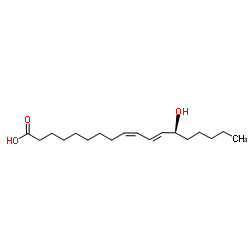Ligand-induced formation of transient dimers of mammalian 12/15-lipoxygenase: a key to allosteric behavior of this class of enzymes?
Igor Ivanov, Weifeng Shang, Lea Toledo, Laura Masgrau, Dmitri I Svergun, Sabine Stehling, Hansel Gómez, Almerinda Di Venere, Giampiero Mei, José M Lluch, Ewa Skrzypczak-Jankun, Angels González-Lafont, Hartmut Kühn
Index: Proteins 80(3) , 703-12, (2012)
Full Text: HTML
Abstract
Mammalian lipoxygenases (LOXs) have been implicated in cellular defense response and are important for physiological homeostasis. Since their discovery, LOXs have been believed to function as monomeric enzymes that exhibit allosteric properties. In aqueous solutions, the rabbit 12/15-LOX is mainly present as hydrated monomer but changes in the local physiochemical environment suggested a monomer-dimer equilibrium. Because the allosteric character of the enzyme can hardly be explained using a single ligand binding-site model, we proposed that the binding of allosteric effectors may shift the monomer-dimer equilibrium toward dimer formation. To test this hypothesis, we explored the impact of an allosteric effector [13(S)-hydroxyoctadeca-9(Z),11(E)-dienoic acid] on the structural properties of rabbit 12/15-LOX by small-angle X-ray scattering. Our data indicate that the enzyme undergoes ligand-induced dimerization in aqueous solution, and molecular dynamics simulations suggested that LOX dimers may be stable in the presence of substrate fatty acids. These data provide direct structural evidence for the existence of LOX dimers, where two noncovalently linked enzyme molecules might work in unison and, therefore, such mode of association might be related to the allosteric character of 12/15-LOX. Introduction of negatively charged residues (W181E + H585E and L183E + L192E) at the intermonomer interface disturbs the hydrophobic dimer interaction of the wild-type LOX, and this structural alteration may lead to functional distortion of mutant enzymes.Copyright © 2011 Wiley Periodicals, Inc..
Related Compounds
| Structure | Name/CAS No. | Molecular Formula | Articles |
|---|---|---|---|
 |
13S-hydroxyoctadecadienoic acid
CAS:29623-28-7 |
C18H32O3 |
|
Light exposure at night disrupts host/cancer circadian regul...
2014-01-01 [PLoS ONE 9(8) , e102776, (2014)] |
|
Doxorubicin resistance in breast cancer is driven by light a...
2015-08-01 [J. Pineal Res. 59 , 60-9, (2015)] |
|
Implications of chemokines, chemokine receptors, and inflamm...
2014-04-01 [J. Leukoc. Biol. 95(4) , 575-85, (2014)] |
|
Effect of ω-3 and ω-9 fatty acid rich oils on lipoxygenases ...
2010-01-01 [Lipids Health Dis. 9 , 112, (2010)] |
|
Roles of peroxisome proliferator-activated receptor-alpha an...
2010-12-01 [Am. J. Respir. Cell. Mol. Biol. 43(6) , 674-83, (2010)] |